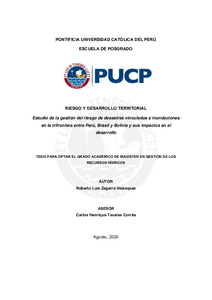| dc.contributor.advisor | Tavares Corrêa, Carlos Henrique | |
| dc.contributor.author | Zegarra Velasquez, Roberto Luis | |
| dc.date.accessioned | 2020-10-05T18:20:39Z | |
| dc.date.available | 2020-10-05T18:20:39Z | |
| dc.date.created | 2020 | |
| dc.date.issued | 2020-10-05 | |
| dc.identifier.uri | http://hdl.handle.net/20.500.12404/17180 | |
| dc.description.abstract | La presente investigación tiene la finalidad de Identificar los lineamientos generales
para la formulación de un Plan Integrado de Gestión del Riesgo para la trifrontera
formada entre Perú, Brasil y Bolivia y así fortalecer las capacidades de resiliencia
territorial y otorgar sostenibilidad a las propuestas de desarrollo.
Para este fin se realizó un reconocimiento de campo, así como entrevistas y
encuestas, las mismas que revelan el nivel de vulnerabilidad territorial y poblacional
que sufre la población.
Como resultado de la búsqueda de un plan integrado trifronterizo de gestión del riesgo
para fortalecer las capacidades de resiliencia territorial se identificaron algunos
lineamientos, entre ellos podremos citar:
• La institucionalización de un Comité Trifronterizo existente pero no reconocido.
• La implementación de mecanismos de fiscalización de mitiguen la tala
indiscriminada, mediante un Plan Integrado en Contra la Deforestación que puede
ser coordinado con el gobierno brasileño que ya viene implementando este tipo de
medidas.
• Es necesario impulsar la reforestación de riberas para evitar el arrastre de
sedimentos y obras de protección de riberas.
• La realización de simulacros debería ser más frecuentes y no se debe limitar a
simulacros locales.
• Se debe invertir en una red de medición de niveles de río, lo cual serviría para
ampliar la red existente de alerta temprana manejada por Brasil, además de servir
para mejorar los estudios tanto de investigación como de proyección presupuestal
en obras y acciones de prevención.
Es necesario resaltar que, durante la investigación en todo momento se identificó que,
para los pobladores de Iñapari, Assis Brasil y Bolpebra las fronteras no existen y ante
las inundaciones todos actúan como uno solo, se apoyan desinteresadamente y tratan
de mejorar su calidad de vida. A pesar de ello, sus gobiernos locales juegan un rol
importante en el progreso local. | es_ES |
| dc.description.abstract | The purpose of this research is to identify the general guidelines for the formulation of
an Integrated Risk Management Plan for the three-tier road between Peru, Brazil and
Bolivia, thus strengthening territorial resilience capacities and granting sustainability to
development proposals.
For this purpose, a field survey was carried out, as well as interviews and surveys,
which reveal the level of territorial and population vulnerability suffered by the
population.
As a result of the search for a three-tier integrated risk management plan to strengthen
territorial resilience capacities, some guidelines were identified, among them we can
mention:
• The institutionalization of an existing but unrecognized Trifronterizo Committee.
• The implementation of control mechanisms to mitigate indiscriminate felling,
through an Integrated Plan Against Deforestation that can be coordinated with the
Brazilian government that is already implementing this type of measure.
• It is necessary to promote the reforestation of riverbanks to avoid the dragging of
sediments and river protection works.
• The conduct of drills should be more frequent and should not be limited to local
drills.
• Investments must be made in a river level measurement network, which would
serve to expand the existing early warning network managed by Brazil, as well as
to improve research studies and budget projections in works and prevention
actions.
It is necessary to highlight that during the investigation at all times it was identified that,
for the inhabitants of Iñapari, Assis Brasil and Bolpebra, the borders do not exist and in
the face of the floods they all act as one, support themselves selflessly and try to
improve their quality of life. Despite this, their local governments play an important role
in local progress. | es_ES |
| dc.description.uri | Tesis | es_ES |
| dc.language.iso | spa | es_ES |
| dc.publisher | Pontificia Universidad Católica del Perú | es_ES |
| dc.rights | info:eu-repo/semantics/openAccess | es_ES |
| dc.rights.uri | http://creativecommons.org/licenses/by/2.5/pe/ | * |
| dc.subject | Gestión de riesgos | es_ES |
| dc.subject | Desastres naturales--Prevención | es_ES |
| dc.subject | Fronteras territoriales | es_ES |
| dc.subject | Inundaciones | es_ES |
| dc.title | Riesgo y desarrollo territorial: Estudio de la gestión del riesgo de desastres vinculados a inundaciones en la trifrontera entre Perú, Brasil y Bolivia y sus impactos en el desarrollo | es_ES |
| dc.type | info:eu-repo/semantics/masterThesis | es_ES |
| thesis.degree.name | Maestro en Gestión de los Recursos Hídricos | es_ES |
| thesis.degree.level | Maestría | es_ES |
| thesis.degree.grantor | Pontificia Universidad Católica del Perú. Escuela de Posgrado | es_ES |
| thesis.degree.discipline | Gestión de los Recursos Hídricos | es_ES |
| renati.discipline | 522117 | es_ES |
| renati.level | https://purl.org/pe-repo/renati/level#maestro | es_ES |
| renati.type | http://purl.org/pe-repo/renati/type#tesis | es_ES |
| dc.publisher.country | PE | es_ES |
| dc.subject.ocde | https://purl.org/pe-repo/ocde/ford#1.05.08 | es_ES |






